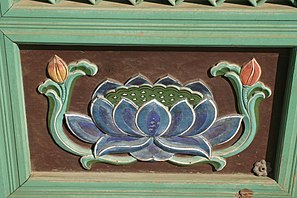Dancheong
You can help expand this article with text translated from the corresponding article in Korean. (August 2014) Click [show] for important translation instructions.
|
| Dancheong | |
 A dancheong in Seoul. | |
| Korean name | |
|---|---|
| Hangul | 단청 |
| Hanja | |
| Revised Romanization | dancheong |
| McCune–Reischauer | tanch'ŏng |
Template:Contains Korean text Dancheong (Korean: 단청) refers to Korean traditional decorative coloring on wooden buildings and artifacts for the purpose of style. It literally means "cinnabar and blue-green" in Korean.[1] It is based on five basic colors; blue (east), white (west), red (south), black (north), and yellow (center).[2][3] Dancheong has various symbolic meanings. Dancheong also represented social status and rank by using various patterns and colors.[citation needed] It functions not only as decoration, but also for practical purposes such as to protect building surfaces against temperature and to make the crudeness of materials less conspicuous. Applying dancheong on the surfaces of buildings require trained skills, and artisans called dancheongjang (단청장) designed the painted patterns.[3][4][5]
History

The origin of dancheong can be traced from cave paintings and wall paintings which appeared more than 20,000 years ago in the history of mankind, although they may be served for different purposes and functions from the stylized dancheong.[5]
In the 12th century a document titled Goryeo Do-Kyung (高麗圖經) which literally means "Illustrated Account of Goryeo" (918-1392), the Chinese author Xu Jing described the luxurious dancheong on the places at that time. Goryeo Do-Kyung illustrates the dancheong in detail that the handrail was painted in red and decorated with vine-flowers. The coloring and patterns were very vivid, so that the palace stood out among other royal palaces.[4] There are several examples of the dancheong from the Goryeo period such as Josadang (조사당) of Buseoksa Temple in Yeongju, Geukrakjeon (극락전) at Bongjeongsa Temple in Andong, and Daeungjeon (대웅전) of Sudeoksa Temple in Yesan.[5]
Types of Dancheong
The system of patternes was categorized into four different types based on the structural characteristics and psitions whithin the decorative composition. The four types included:[6]
- Morucho
- Byeoljihwa
- Bidan munui
- Dandong munui
Gallery
-
Dancheong on a building at Gyeongbokgung Palace
-
The interior of Injeongjeon, Changdeokgung
-
Cheongpeongsa Temple in Chuncheon
-
Lotus pattern
-
Dancheong Style Los Angeles
See also
- Architecture of Korea
- Hanok
- Korean Buddhist temples
- Important Intangible Cultural Properties of Korea
References
- ^ "단청(丹靑), dancheong". The Academy of Korean Studies. 2007-05-22.
- ^ "History of Science and Technology in Korea". National Science Museum, South Korea.
- ^ a b Chung Ah-young (2007-05-22). "Dancheong: Spiritual Colors of Korea". The Korea Times.
- ^ a b "Dancheong". Korean Cultural Service, New York.
- ^ a b c 단청 (丹靑) (in Korean). Empas / EncyKorea.
- ^ Korean Culture and Information Service (2010). Guide to the Korean Culture. 13-13 Gwancheol-dong, Jongno-gu Seul 110-111 Korea: Hollym International Corp. p. 181.
{{cite book}}: CS1 maint: location (link)
Sources
- Gareth Barker (2005-08-28). "Traditions of Korea / Dancheong" (137). Sky News.
{{cite journal}}: Cite journal requires|journal=(help) - Keith Pratt; Richard Rutt; James Hoare (1999). Korea: A Historical and Cultural Dictionary. Routledge. pp. 459–460 p. ISBN 0-7007-0463-9.
- "Korean Buddhist Art: Painting: "Tanch'ong"". Buddha Dharma Education Association Inc.
- "Dancheong, A Traditional Korean Art" (in English and Korean). Arirang TV. 2007-09-29.
- "Dancheong: wonderland of colors under eaves". Jogye Order of Korean Buddhism. 2006-07-22.
- "Important Intangible Cultural Properties 48". Cultural Properties Administration of South Korea.
- "Korean Fine Arts" (in English and Korean). National Institute For International Education of South Korea.
- "Dancheong" (in English and Korean). Jung-gu, Seoul.
- Kim In-cheol (2008-05-22). "'Dancheong Red' to Symbolize Seoul". Korea Foundation / Yonhap News.
- ""Dancheong" the Color of Seoul". Seoul Metropolitan Government. 2008-05-22.
- Yoon Sojung (2007-07-17). "Foundation helps European teachers discover Korea". The Korean Culture and Information Service (KOIS).
- 단청 (丹靑) (in Korean). Empas / Britannica.
- 단청안료 (in Korean). Daum / Korea Culture & Content Agency (KOCCA).





